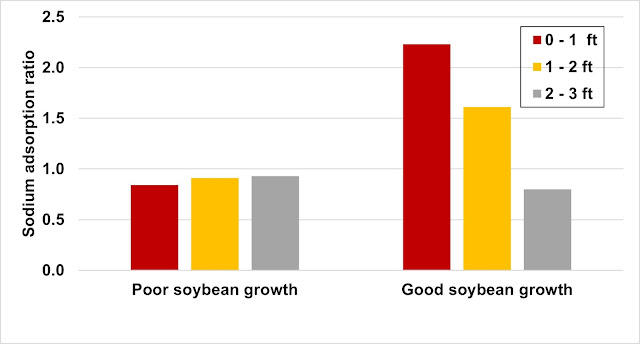This article was written by Angie Peltier, UMN Extension crops educator and Naeem Kalwar, NDSU Extension soil health specialist. This is the second article in a series dedicated to this topic. Click here to read the first article in this series and here to read the second and here to read the third.
Poorly aggregated soils = sodic soils?
Poor soil structure can be a symptom associated with sodic soil, or soils with excessive quantities of sodium ions (Na+) adsorbed to the negatively charged sites on clay particles and organic matter.
Ions are negatively charged (anions) or positively changed (cations). Organic matter and clay particles have a negative charge with numerous cation exchange sites, where different positive ions can form a bond. A soil’s cation exchange capacity (CEC) is its total capacity to hold positively charged ions. Soil tests, which help determine levels of sodicity are exchangeable sodium percent or ESP and sodium adsorption ratio or SAR. For classification purposes, sodic soils have sodium (Na+) ions bound to at least 15% of their cation exchange sites (ESP = 15%) or a SAR of 13. However, ESP and SAR levels much lower than 15 and 13 can cause soil dispersion, especially if soils are shrinking and expanding type. This causes soil aggregates to disintegrate causing many negative effects, including the associated lack of pore space which can limit both water infiltration and gas exchange. Poor water infiltration and gas exchange can negatively affect seed germination, root growth and wind and water erosion.
The soil samples from the Norman County soybean farm were analyzed for sodium adsorption ratio (SAR), which is a measure of how many sodium ions are in a soil in relation to calcium (Ca2+) and magnesium (Mg2+) ions. None of the soil samples from this field had a sodium adsorption ratio higher than 2.23, meaning that neither soil would be considered sodic (Figure 5).
References
Franzen, D., Gasch, C., Augustin, C., DeSutter, T., Kalwar, N. and Wick, A. 2019. Managing saline soils in North Dakota. NDSU Extension publication SF1087.

Comments
Post a Comment